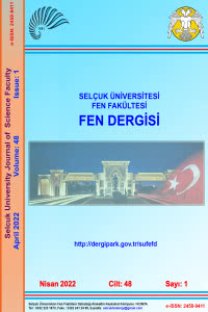Kuyu Yakınında Rezervuar Parametrelerinin Belirlenmesinde Basınç Darbesinin Kullanılmasının İncelenmesi
Bir akışkanın aktığı boruda ani akış hızı değişikliği veya akışın aniden durdurulması boru içerisinde yayılan basınç dalgalanmasına sebep olur. Bu doğal olgu akış hızının ölçümü ve borunun etkin çapının belirlenmesi ve gözlenmesi hesaplamalarında kullanılmıştır. Basınç darbesi olarak da bilinen basınç dalgası kuyu yakınında formasyon geçirimliliği ve storativitesinin tahmininde kullanılabileceği öngörülmektedir. Bu çalışmada, ani vana kapanmasıyla oluşturulan basınç darbesinin yayılımı geçici rejim boru akış modeli ile simüle edilip, bu model analitik geçici rejim rezervuar modeli ile birleştirilmiştir. Birleştirilen model, vana girişinde ölçülen ve hesaplanan basınç değişim verilerini eşleştirme yaklaşımıyla rezervuar parametrelerinin iteratif olarak tahmini işleminde kullanılmıştır. Geliştirilen bu modelleme ve tahmin yaklaşımı bir kuyudaki iki kuyu test verisine rezervuar parametrelerini tahmin etme amacıyla uygulanmıştır. Kuyu civarındaki geçirimlilik ve storativite değerleri ölçülen/hesaplanan veri eşleştirme yöntemiyle elde edilmiştir. Kuyuda iki farklı akış durumunda ölçülen basınç değişimi bilgisinin birleştirilmiş modelle gerçekleştirilen eşleştirme analizi rezervuar parametreleri için çok benzer değerleri işaret etmektedir.
NVESTIGATING USE OF PRESSURE PULSES TO ASSESS NEAR WELLBORE RESERVOIR PARAMETERS
Pressure surge in a pipe due to sudden flow rate change or full-stop of fluid flow is apressure wave propagating in fluid along the pipe. This phenomenon has been used to determine theflow rate and to detect and monitor changes in effective flow diameter. It turns out that the pressuresurge, also known as pressure pulse, can be used to estimate the formation transmissivity and storativityin the near wellbore region. In this study, propagation of pressure pulse generated by sudden valveclosure is simulated with a transient pipe flow model, and it is coupled with a transient analyticalreservoir model. The coupled model is used to estimate the reservoir parameters by history matchingapproach, which is to iterate the transmissivity and the storativity values until an acceptable match isobtained between the measured and simulated pressure history at the upstream of valve. The developedmodeling and estimation scheme is applied with two data sets from a field well test to estimate reservoirparameters. The reservoir parameters transmissivity and storativity in the near wellbore region wereobtained from the history matching analysis. Matching analysis with the coupled model on the recordedwellhead pressure during two tests showing obvious different flowing conditions points out verysimilar reservoir parameter values.
___
- Carey, M. A., Mondal, S., and Sharma, M. M., 2015. Analysis of Water Hammer Signatures for Fracture Diagnostics, SPE Paper 174866 presented the SPE Annual Technical Conference and Exhibition held in Houston, Texas, USA, 28–30 September 2015.
- Chevray, R. and Mathieu, J., 1993. Topics in Fluid Mechanics, Cambridge University Press.
- Chierici, G. L., 1994. Principles of Petroleum Reservoir Engineering Volume 1, Springer-Verlag Berlin.
- Falk, K. 1999. Pressure pulse propagation in gas-liquid pipe flow: modeling, experiments, and field testing, Ph.D. dissertation, NTNU, Trondheim.
- Horne, R.N., 1995. Modern Well Test Analysis, A Computer Aided Approach, 2nd edition, Petroway Inc., USA.
- Howe, M. S., 2006. Hydrodynamics and Sound, Cambridge University Press.
- Ghidaoui, M. S., Zhao, M., McInnis D. A., and Axworthy, D. H., 2005. A Review of Water Hammer Theory and Practice. Applied Mechanics Reviews 58(1), 49-76.
- Gudmundsson, J. S. and Celius, H. K., 1999. Gas-Liquid Metering Using Pressure-Pulse Technology. SPE Paper 56584, Annual Technical Conference and Exhibiton, Houston, 3-6 October 1999.
- Gudmundsson, J. S., Durgut, I., Celius, H. K. and Korsan, K., 2001. Detection and Monitoring of Deposits in Multiphase Flow Pipelines Using Pressure Pulse Technology. 12th International Oil Field Chemistry Symposium, Geilo, 1-4 April 2001.
- LeVeque. R. J., 2002. Finite Volume Methods for Hyperbolic Problems. Cambridge University Press.
- Livescu, S., Watkins, T. J, 2014. Water Hammer Modeling in Extended Reach Wells. Paper SPE 168297 presented SPE/ICoTA Coiled Tubing & Well Intervention Conference and Exhibition, The Woodlands, TX, USA, 25-26 March 2014.
- Mambretti, S., 2014. Water Hammer Simulations. WIT Press, Southampton, Boston.
- Prümmer, R. 2009. History of Shock Waves, Explosions and Impact – A Chronological and Biographical Reference, Peter O. K. Krehl. Propellants, Explosives, Pyrotechnics, 34: 458.
- Santarelli, F.J., Skomedal, E., Markestad, P., Berge, H.I., Nasvig, H., 2000. Sand Production on Water Injectors: Just How Bad Can It Get? SPE Drill. & Compl 15(2): 132.
- Vaziri, H., Nouri, A., Hovem, K., Wang, X., 2007. Computation of Sand Production in Water Injectors. Paper SPE 107695 presented at the European Formation Damage Conference, Scheveningen, 30 May-1 June 2007.
- Wang, X., Hovem, K., 2008. Water Hammer Effects on Water Injection Well Performance and Longevity. Paper SPE 112282 presented at the SPE International Symposium and Exhibition on Formation Damage Control, Lafayette, 13-15 February 2008.
- Zazovsky, A., Tetenov, E. V., Zaki, K. S. and Norman W. D., 2014. “Pressure Pulse Generated by Valve Closure: Can It Cause Damage?” Paper SPE 168191 presented at SPE International Symposium and Exhibition on Formation Damage Control held in Lafayette, Louisiana, USA, 26–28 February 2014.
- ISSN: 2147-9364
- Yayın Aralığı: Yılda 2 Sayı
- Başlangıç: 2013
- Yayıncı: Selçuk Üniversitesi Mühendislik Fakültesi
Sayıdaki Diğer Makaleler
A NOVEL APPROACH BASED ON ELEPHANT HERDING OPTIMIZATION FOR CONSTRAINED OPTIMIZATION PROBLEMS
THE EFFECT OF GRINDING MEDIA PERFORMANCE ON WET MILLING OF CALCITE
KARMAŞIK DALGACIK DÖNÜŞÜMÜ TABANLI YAPAY SİNİR AĞLARI İLE YÜZ ALGILAMA
NVESTIGATING USE OF PRESSURE PULSES TO ASSESS NEAR WELLBORE RESERVOIR PARAMETERS
İsmail DURGUT, Jon S. GUDMUNDSSON, Alberto Di LULLO
Tamer ÖZYİĞİT, Seçil SATIR, Salih Murat EGİ, Miraç MEMİŞOĞLU
Batuhan Eren ENGİN, Turan PAKSOY
GÜÇLENDİRME TEKNİĞİ OLARAK YENİ NESİL ÖN ÜRETİMLİ BETON PANEL UYGULAMASININ ARAŞTIRILMASI
İsmail Kutlugün AKBAY, Tonguç ÖZDEMİR, Rükan GENÇ, Ahmet GÜNGÖR
Kısıtlı Optimizasyon Problemleri için Fil Sürüsü Optimizasyonu Tabanlı Yeni Bir Yaklaşım
